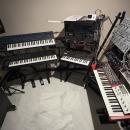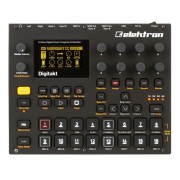habré entendido mal pero yo juraría que había oído cuantizar ya me extrañaba de todas maneras si se puede procesar tampoco esta nada mal.
Usuarios Elektron Digitakt

OFERTAS Ver todas
-
-16%UA Apollo X4 Gen2 Essentials+
-
-5%Kawai ES-60
-
-29%UA Apollo x6 Gen2 Essentials+



Buenas
Sabríais explicar los diferentes trig condition ? No entiendo muy bien lo de "true"
FILL is only true (will activate the note trig) when fill mode is active (see above).
FILL is true when FILL is not.
PRE is true if the most recently evaluated note condition on the same track was true.
PRE is true when PRE is not.
NEI is true if the most recently evaluated note condition on the neighbor track was true. The neighbor track is the track before the one being edited. For example, the neighbor track of track 4 is track 3. If no conditions exist on the neighbor track, the condition is false and no sound is played.
NEI is true when NEI is not.
1ST is true the first pattern cycle (until the pattern has looped).
1ST is true when 1ST is not.
X% is a probability condition. There is an x% chance of it being true.
A:B A sets how many times the pattern plays before the trig condition is true. B sets how many times the pattern plays before the count is reset and starts over again. This then repeats indefinitely. For example, with a setting of 2:4, the trig condition will be true the second time the pattern plays and then the sixth, the tenth, and so on. If you have the setting 3:5 the trig condition will be true the third time the pattern plays and then the eight, the thirteenth, and so on.
Sabríais explicar los diferentes trig condition ? No entiendo muy bien lo de "true"
FILL is only true (will activate the note trig) when fill mode is active (see above).
FILL is true when FILL is not.
PRE is true if the most recently evaluated note condition on the same track was true.
PRE is true when PRE is not.
NEI is true if the most recently evaluated note condition on the neighbor track was true. The neighbor track is the track before the one being edited. For example, the neighbor track of track 4 is track 3. If no conditions exist on the neighbor track, the condition is false and no sound is played.
NEI is true when NEI is not.
1ST is true the first pattern cycle (until the pattern has looped).
1ST is true when 1ST is not.
X% is a probability condition. There is an x% chance of it being true.
A:B A sets how many times the pattern plays before the trig condition is true. B sets how many times the pattern plays before the count is reset and starts over again. This then repeats indefinitely. For example, with a setting of 2:4, the trig condition will be true the second time the pattern plays and then the sixth, the tenth, and so on. If you have the setting 3:5 the trig condition will be true the third time the pattern plays and then the eight, the thirteenth, and so on.

FILL es que ese paso "suena" cuando pulsas la tecla fill (PAGE, mientras suena el patrón)
FILL con rallita arriba es que suena cuando no se utiliza la tecla fill
PRE es que ese paso suena si suena el anterior
PRE con rallita arriba, lo contrario
NEI es que ese paso suena si hay una condición en el paso en la pista anterior (si estamos en la pista 4, pues la 3)
NEI con rallita arriba, lo contrario
1ST es que suena sólo en el primer ciclo del patrón, la segunda vez que se ejecute no sonará
1ST con rallita arriba, lo contrario
X%, es la probabilidad en % de que ese paso suene
A:B establece cuantas veces suene el patrón antes de que "suene el paso" A sería las veces por primera vez (un 2 sería la segunda vez que suena el patrón) y el número B es cuántas veces se tiene que repetir a partir de ahí para que suene (por ej. 3 sería cada 3 veces, así, 2:3 significa que para que suene el paso lo hará la segunda vez que suene el patrón y a partir de ahí cada tres patrones (la quinta vez, la octava vez,...)
espero haberte ayudado
FILL con rallita arriba es que suena cuando no se utiliza la tecla fill
PRE es que ese paso suena si suena el anterior
PRE con rallita arriba, lo contrario
NEI es que ese paso suena si hay una condición en el paso en la pista anterior (si estamos en la pista 4, pues la 3)
NEI con rallita arriba, lo contrario
1ST es que suena sólo en el primer ciclo del patrón, la segunda vez que se ejecute no sonará
1ST con rallita arriba, lo contrario
X%, es la probabilidad en % de que ese paso suene
A:B establece cuantas veces suene el patrón antes de que "suene el paso" A sería las veces por primera vez (un 2 sería la segunda vez que suena el patrón) y el número B es cuántas veces se tiene que repetir a partir de ahí para que suene (por ej. 3 sería cada 3 veces, así, 2:3 significa que para que suene el paso lo hará la segunda vez que suene el patrón y a partir de ahí cada tres patrones (la quinta vez, la octava vez,...)
espero haberte ayudado







Equipo relacionado
Hilos similares
Nuevo post
Regístrate o identifícate para poder postear en este hilo




